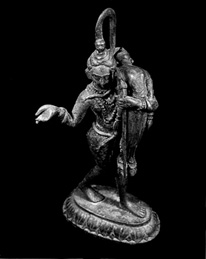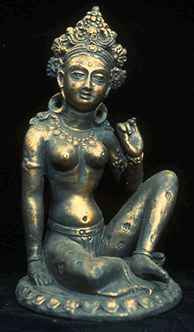Sati the Goddess

Shiva carrying the dead Sati.17th/18th-century bronze. Gwalior Museum. Photograph curtesy of the Archelogivcal Survey of India. |
The myth of Sati appears to have little to do with the practice of sati. Sati is said to be an earlier incarnation of the goddess Paravati. Both are the wives of the acetic god ´Siva, and both are known as paradigmatic good wives. Sati committed suicide, but not by throwing herself onto ´Siva's funeral pyre as the name suggests. Sati killed herself when her father insulted her and ´Siva by refusing to invite them to a sacrifice he was performing, on account of ´Siva's acetic appearance and odd behavior. Sati was so enraged at her father's snub, that she threw herself into a fire. Yet she did not burn alive, ´Siva is said to have pulled her intact body from the fire and proceeded to carry her body throughout the universe in his grief. Vishnu finally relieved ´Siva of his grief by slicing off pieces of her body until Sati's body was gone. Shrines are established at scared places, pithas, where a piece of Sati's body landed4. |
There are several ways that the myth of Sati does not relate to the practice of
sati. Sati commits suicide in response to her fathers' snub, not her husband's death. She is not a widow when she throws herself into the fire (not a pyre) and she does not actually burn, proven by the fact that ´Siva is able to carry her complete body. This myth seems to have nothing to do with the idea of joining a husband in the afterlife since ´Siva is very much alive when Sati dies5. Yet many things about Sati's origins connect to the practice of sati and a satimata. ´Siva may not have been dead when Sati committed suicide, but if the object
of the practice of sati is to transform oneself through death and pain in order to transform one's husband, then Sati did accomplish this. Sati's death is often viewed as the catalyst that caused the evolution of ´Siva from a purely ascetic god, into one who became involved in the world. Because of Sati's death, ´Siva became involved with Sati's father's sacrifice, symbolizing his creative participation in the world6.
If a man dies before his wife, his wife is said to have not followed the proper rituals that work to protect her husband. By committing sati, the wife is able to correct this situation. Her sacrifice is what enables her not only to remain with her husband in the afterlife, but to also grant blessings on him, ensuring his good welfare. So by performing sati, a wife changes an inauspicious event into one of great honor. In this way, she transforms herself and her husband through her pain and the sacrifice of her body. Sati accomplishes this in her act. She reconstructs ´Siva from an ascetic god into a god of this world, thereby connecting established religion with asceticism.
|
Sati's pain and suffering allows humans to gain contact with ´Siva in another way. As pieces of her body fall to the earth, Sati sacralizes the earth, allowing humans to feel the power of ´Siva through the linga (´Siva follows sati to the earth by embedding his linga into her yoni)7. In this way, Sati's body is transformed intohe sacred earth through an act of pain (Vishnu's cutting of her body). Sati's body then transforms the earth into a place where humans can gain contact with her husband ´Siva. These acts of transformation are what connect the seemingly unrelated myth of Sati to the practice of sati. It is pain and the destruction of a good wife's body that allows a metamorphism to occur. An inauspicious situation becomes a celebratory event, a woman becomes a goddess, and the husbands themselves are changed into better beings. It is the sacrifice of a woman's body that creates these transformations. | 
The Goddess Sati as Uma. |

